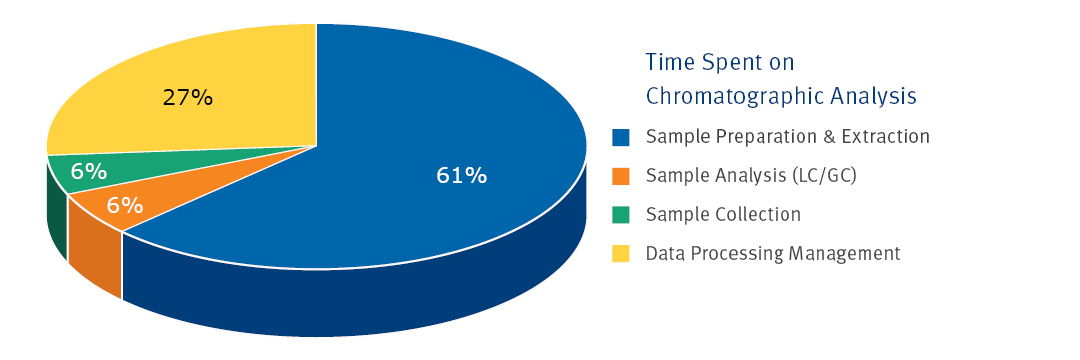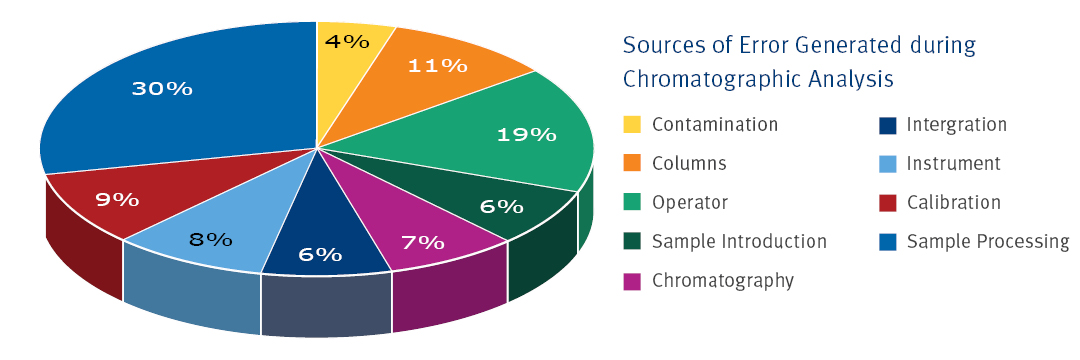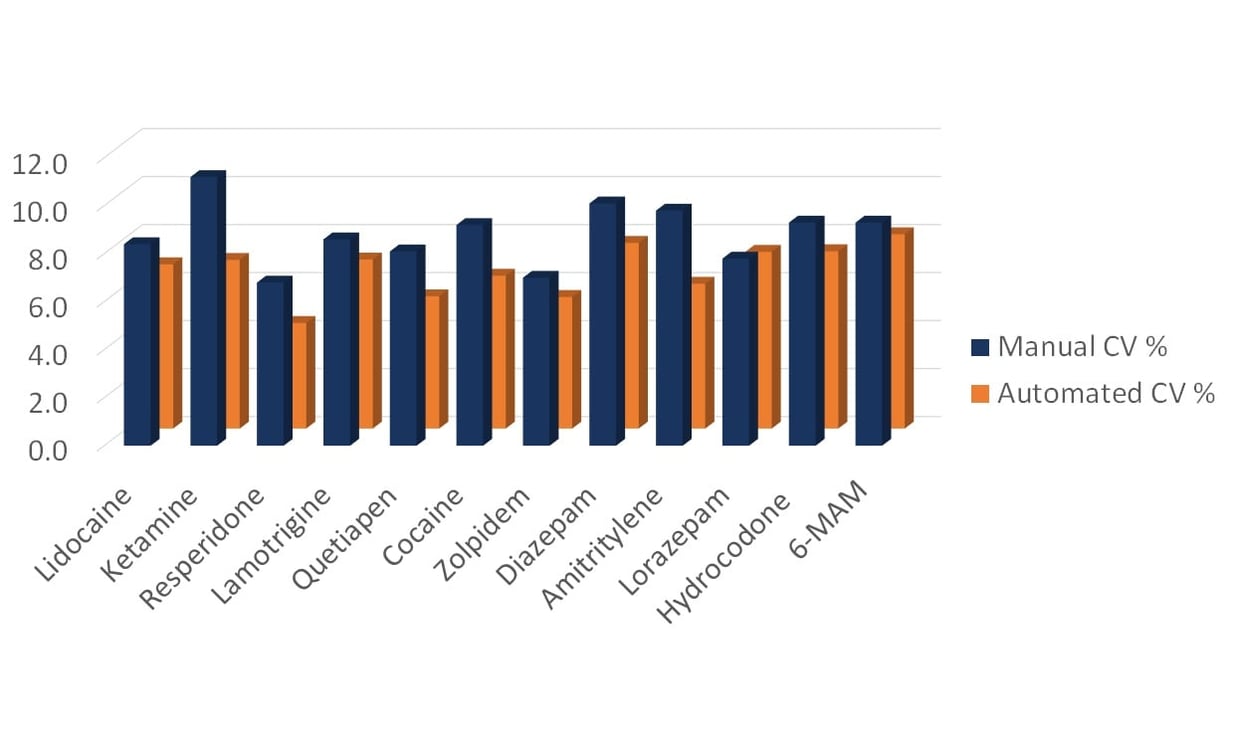
The main purpose of sample preparation is to extract the target analyte(s) from the sample matrix, allowing them to be measured by the chosen analytical technique, such as LC-MS/MS or GC-MS. This can sound simple, but there are nearly as many sample preparation techniques as there are sample types. Add to this pressure facing many laboratories that includes growing numbers of samples, the need for faster turnaround times and the need to reduce costs, and suddenly sample preparation isn’t quite so straightforward.
Today’s analytical laboratories most commonly analyze:
Sample preparation is seen as a necessary evil in the analytical process. It is often overlooked, sitting in between sampling and the more glamorous analytical (often chromatographic) end point. Yet, the question remains, why invest so much on analytical equipment if you’re not going to optimize its performance by ensuring that samples are in a form that will maximize analytical power? As we will see here, automation plays a central role in maximizing the efficiency of sample prep.
This is a lengthy review packed with useful information about sample preparation. Download to read at your leisure !
There might also be a need for further concentration (by evaporation) or clean up.
For liquid samples, the focus is on sample clean up and concentration, based on techniques such as:
Achieving effective sample preparation means facing a number of challenges, including:
Complicated workflows
Sample preparation techniques cover a range of complexity, from simple SLE protocols to more specific SPE, and even chemical derivatization procedures. Despite these complexities, trace level analysis requires sample preparation to extract analytes from solid matrices, remove matrix interferences, and concentrate samples so that analytical instruments can measure analytes.
Time consuming workflows
Pre-analytical sample preparation and extraction can be the most time consuming part of an assay (Fig. 1). As analytical run times becoming shorter and shorter (1–2 min is common in UPLC-MS/MS), multiple, laborious steps can make sample preparation a real bottleneck.

Figure 1: Survey results for the distribution of time that analytical chemists spend on sample analysis Source: Majors, 1991 [1]
Labor intensive workflows
The need to perform time-consuming and repetitive steps locks up skilled staff with laborious and boring tasks when they could be more usefully deployed. This can add unnecessary personnel cost to every sample and reduce profitability.
The risk of errors
Bored people get tired and make mistakes, and the risk increases with the complexity of sample preparation. Errors made in sample processing and extraction cannot be corrected, even using the most advanced analytical methods available. The most significant sources of errors in chromatographic analyses are from sample processing (30 %) and operator error (19 %; Fig. 2).

Figure 2: Survey results for the distribution of errors generated during sample analysis Source: Majors, 1991 [1]
High cost
If you have made a major investment in a top of the range, highly sophisticated LC-MS/MS instrument, why spend even more on sample preparation, including consumables, solvents, pipette tips, and personnel? Cutting down on sample preparation can, however, be false economy. Cleaner samples mean more robust, reliable analyses and less expensive instrument downtime due to maintenance and cleaning.
Impact on analyte recovery
Adding steps in sample preparation can reduce analyte recovery. This can be avoided with the right approach.
Automating your sample preparation process has many benefits.
Improved throughput and efficiency
Automating the sample prep procedure can speed up processing of multiple samples, helping to eliminate the sample prep bottleneck. A recent study demonstrated a 33 % reduction in solid-phase extraction processing time for 96 samples compared to the equivalent manual process (2). Skilled analysts can be redeployed to other more demanding tasks, such as data analysis. This increases their job satisfaction, reduces stress, and makes for a happier lab.
High analyte recovery
A robust, optimized sample prep procedure specifically designed to meet your analytical goals and performed by well-trained staff can routinely deliver an analyte recovery of >90%.
Improved data and error reduction
Unlike people, automation systems are perfect for performing the same task over and over again, and they don’t make mistakes or get bored. Eliminating sample-to-sample or analyst-to-analyst variation improves accuracy and precision compared to manual sample processing methods. Recoveries are likely to be greater when using an automated system and the precision of results will improve (Fig. 3).

Figure 3: Comparing CV% Responses for Automated Vs. Manual Extraction Source: Youssef et al, 2019 [2]
Reduced cost per sample
Higher throughput and more efficient use of skilled staff reduce cost per sample, and with the right automation system you may also be able to make the most efficient use of consumables such as pipette tips.
There are so many factors to consider, so we will focus on some of the most important factors when automating sample preparation of liquid samples for chromatographic analysis.
Firstly, you need to define what you want the automation to achieve – think about the pain points in your current processes, and how these might be solved by automating the process.
The sample type will have a major impact on the system specification:
Stand-alone vs integrated systems
The sample preparation system can be either stand alone, or integrated with an analytical platform, so that a sample is loaded, prepared, and analyzed within one device. Both have their advantages.
Standalone sample preparation does not tie up analytical instrumentation, and you may have more flexibility regarding sample prep technique and sample type. However, integrating preparation and analysis essentially eliminates user intervention after the samples and methods have been loaded onto the machine, and that frees lab members to do other things. On the other hand, a fully integrated system might be more complex to maintain. For example, if one component goes down then the whole process has to be stopped until the problem is solved. On-line SPE is the most common ‘fully integrated’ automated sample prep technique. Other formats and techniques are viewed as discrete steps in a larger workflow.
Ability to automate different sample preparation techniques on a single system
This provides loads of flexibility, which is great for a lab that handles multiple applications, but also might mean the system is more complex to set up or run. Choose a system that is designed and optimized for different techniques to minimize complexity and potential bottlenecks.
What type and volume of sample will you be extracting?
The best option for a large volume (1 L) wastewater sample will not be the same as for a low volume (100 μL or less) blood sample. For large volume samples, an automated sample prep automation system will need to be able to load samples at high flow rates, for the best efficiency gains, and the system may also need to handle more challenging samples with high levels of particulates. Processing lower volume samples, on the other hand, offers more options regarding commonly automated techniques and formats.
What sample preparation technique will be used?
‘Flow through’ techniques such as solid-phase extraction are often automated. These are adaptable sample preparation techniques, commonly used to extract both biological fluids and environmental water samples. They have the advantage of being able to both clean up complex samples (for example when isolating a drug from a blood sample) and achieve high analyte concentration, which is important when analyzing very levels of analytes. Alternatively, you might want to automate a technique such as protein precipitation or supported liquid extraction.
Compared to traditional techniques such as liquid-liquid extraction, these flow-through techniques are often more amenable to automation. Modern labs are validating new protocols using high-throughput, high reproducibility PPT and SLE workflows to update historic LLE techniques.
|
Automated technique |
Automation compatibility |
Sample compatibility (automated processing) |
|
Solid-Phase Extraction (SPE) |
Good |
Low μL – multi L |
|
Liquid-Liquid Extraction |
Poor |
Up to 1 mL |
|
Protein Precipitation |
Good* |
Low volume blood-based samples |
|
Supported Liquid Extraction |
Good |
Aqueous samples up to 2 mL |
|
Filtration |
Good |
Low μL – multi L |
* Many steps difficult to automate. Supported liquid extraction uses the same principles, but is optimized for automated process.
**Using filtration to remove precipitated protein rather than centrifugation.
What sample preparation format?
If we just take solid-phase extraction, there are many formats that might be used in an automated process.
|
Format |
Sample types |
Comments |
|
96-Well SPE plate |
Biological fluids |
Volumes up to 1 mL Good for parallel processing, high throughput applications. |
|
SPE Tips |
Biological fluids |
Volumes up to 1 mL Good for parallel processing, high throughput applications. |
|
SPE Column or cartridge |
Biological fluids, water samples, plant and animal tissues |
Multiple sizes available. Suitable for many sample types. |
|
SPE Disk |
Larger volume water samples |
Great for high flow rates, can handle high particulate levels. |
|
On-line SPE column |
Biological fluids or clean water samples |
Typically low μL to a few mL Not good for very dirty samples. Fully integrated with analytical system. |
Ease of use
Sample prep automation devices and systems range from simple systems that can perform a few processes, to highly complex, sophisticated liquid handling systems that can do nearly everything.
Software and user interfaces can make the difference between a speedy set up and a laborious validation. A good software and user interface requires minimal training to get the system up and running. Some automation platforms require system experts on site, which is an important aspect in maximizing productivity and getting the most from your investment.
Don’t forget evaporation
Following many of these sample preparation techniques, an evaporation step- to either concentrate or solvent exchange- prior to analysis will be required after sample clean up. This is part of the sample preparation process.
In the world of automated sample prep, data organization, traceability, and accountability are paramount. Samples must be tracked, data collected and recorded, staff adequately trained, and laboratory equipment properly maintained and calibrated. These seemingly routine lab operations all fall under the mandate of Good Laboratory Practices (GLP).
Taken together, the principles of GLP are designed to ensure data produced from studies possess the quality and integrity needed to support research for approved products, that are regulated by government institutions like the FDA or multinational organizations such as The Organization for Economic Co-operation and Development (OECD). This can include foodstuffs (dyes or preservatives), medical devices, or pharmaceuticals for both humans and animals, all of which can be subjugated to different levels of GLP scrutiny.
It’s important to point out that while GLP serves to harmonize quality assurance for studies, it does not provide a template for GLP laboratory operations. However, introducing an automated sample prep system will increase lab efficiency and allow a lab to handle multiple levels of sample throughput, provide guidance to GLP adherence, and at a minimum, help organize your sample prep workflow.
Features needed to meet even the most modest of GLP requirements can be distilled into four categories:
Employing the use of an automated sample prep system can allow laboratories to efficiently adhere and maintain GLP doctrine, to ensure the quality and reliability of routine analyses.
Automating your sample prep can have significant benefits, but finding the right solution to meet your needs can be a challenge. Begin with defining what you want to change in your lab with automation. Talk to your peers, talk to manufacturers and arrange to see the various systems in action, so you truly understand what they can do, but also their limitations. Once the optimal automation solution is in place, you will see clear benefits in improved laboratory efficiency, increased data quality, and reduced cost per sample.
If you found this useful, why not download for future reference?
Biotage is a Global Impact Tech Company committed to solving society’s problems. We offer workflow solutions and products to customers in Drug Discovery and Development, Analytical Testing and Water and Environmental Testing.